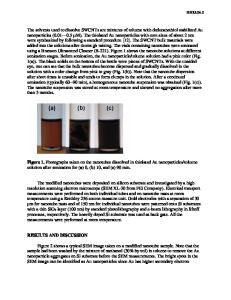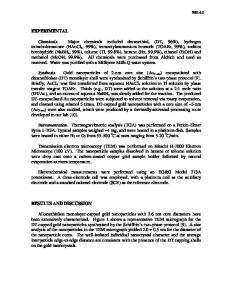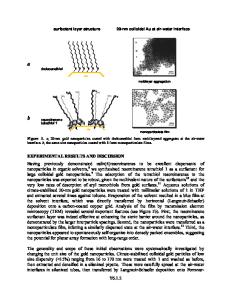Single Molecular Magnet - Gold Nanoparticle Composites
- PDF / 230,376 Bytes
- 6 Pages / 612 x 792 pts (letter) Page_size
- 81 Downloads / 266 Views
1198-E03-02
Single Molecular Magnet - Gold Nanoparticle Composites
G. Balaji1, G. L. Bovenkamp1,2,3, V. Palshin1 and C. S.S.R. Kumar1* 1
Center for Advanced Microstructures & Devices (CAMD), Louisiana State University 6980 Jefferson Highway, Baton Rouge, LA 70806, USA. 2 Institute of Physics, Bonn University, Nussallee 12, 53115 Bonn, Germany 3 Canadian Light Source, University of Saskatchewan, 101 Perimeter Road, Saskatoon, SK Canada S7N 0X4 ABSTRACT
Single molecular magnets (SMM) are an important class of magnetic materials receiving great attention due to their properties and potential applications in ultrahigh density data storage. We have demonstrated that a functionalization of Mn12-acetate [(Mn12O12(RO)16(H2O)4)] where R = alkyl group, with a thiol (–SH) group is possible through ligand exchange reaction. In this reaction cysteine replaces acetate in Mn12-acetate thereby yielding Mn12-cysteinate. In an additional step, the product of the ligand exchange was bound to gold to get a novel SMM-Au composite. These composites were characterized using infrared spectroscopy (IR), high resolution transmission microscopy (HRTEM) and x-ray absorption near edge spectroscopy (XANES) techniques. INTRODUCTION
In the past decade SMM attracted a great deal of interest, especially those based on manganese such as Mn12-acetate due to their potential applications in ultrahigh density data storage and quantum computing devices [1]. The focus so far has been in finding different derivatives of Mn or other transition element based complexes in order to further enhance the required magnetic properties of SMM [2]. Also, there have been efforts to arrange SMM on planar surfaces and to understand their magnetic properties [3-6]. Here in we propose a novel approach to modify the magnetic behavior of SMM though their functionalization with nanoparticles. As a part of this study, we investigated binding SMM to gold nanoparticles (NP) by a multi-step synthetic process. We present the description of the synthesis as well as the characterization of single molecular magnet - gold nanoparticle composites. The composite was characterized using several methods including infrared spectroscopy (IR), HRTEM and synchrotron radiation-based XANES. MATERIALS AND METHODS
The reaction scheme for the synthesis of SMM-nanoparticle hybrid has been depicted in figure 1. Mn12-acetate [(Mn12O12(AcO)16(H2O)4)] (1) was prepared by using the procedure
reported by Liz [7]. As gold nanoparticle can bind to sulfur easily, a cysteinate derivative of (1) was prepared by ligand exchange of acetate groups by cysteine groups. 0.25 g of cysteine and 0.25 g of (1) was stirred in 7 ml toluene under vacuum until all the solvent evaporated. This procedure was repeated twice. The resultant mixture was extracted into minimum ethanol and evaporating ethanol from its fraction resulted in a brown solid which is Mn12-cysteinate [(Mn12O12(Cyst)16(H2O)4)] (2). Gold nanoparticles (NP) capped by dodecanethiol were prepared by using method adopted by Gross [8]. 0.2 g of d
Data Loading...











